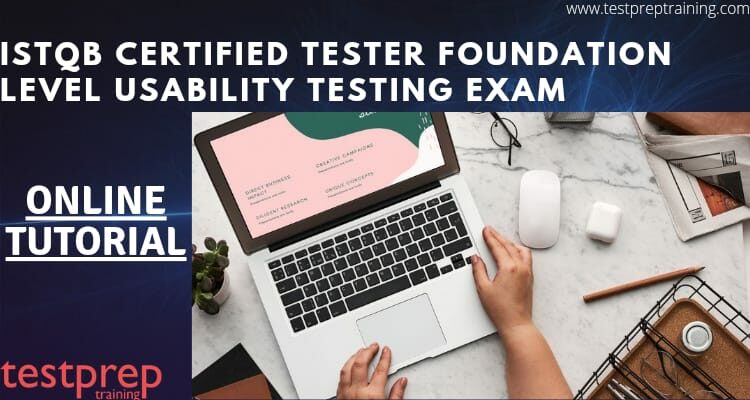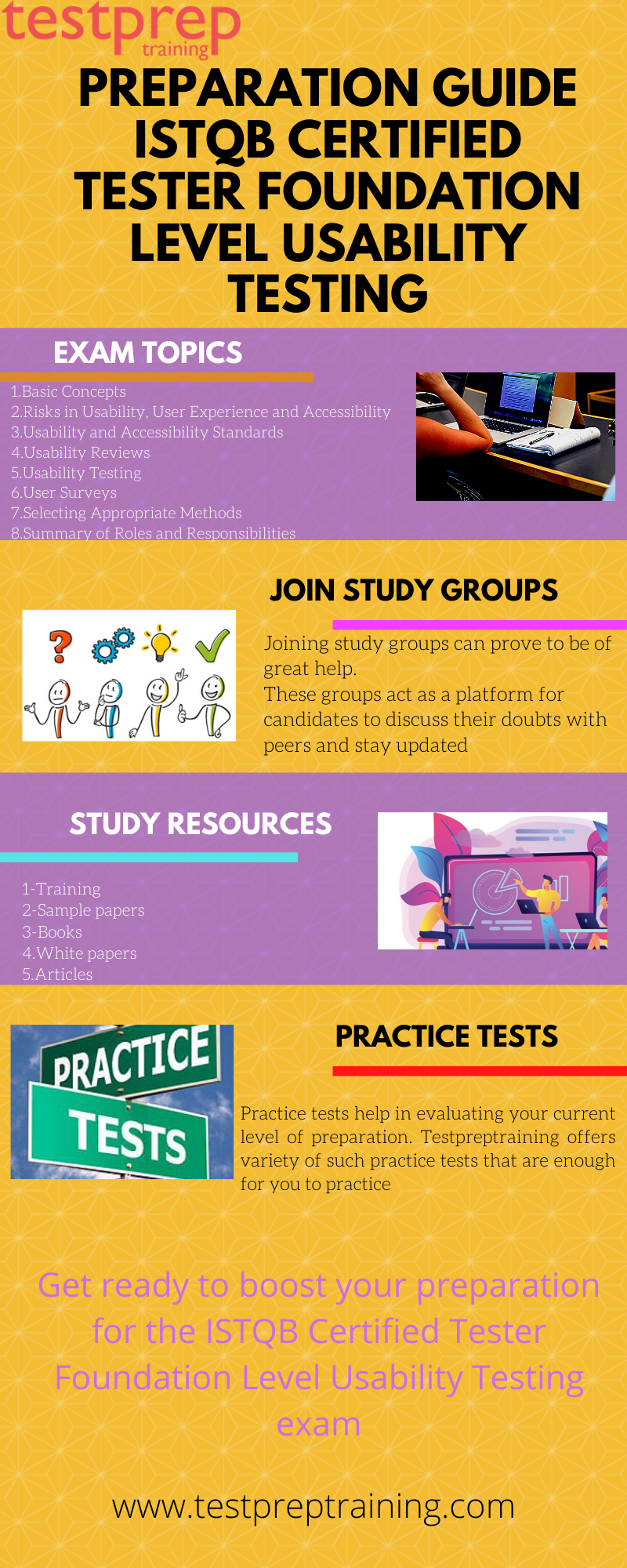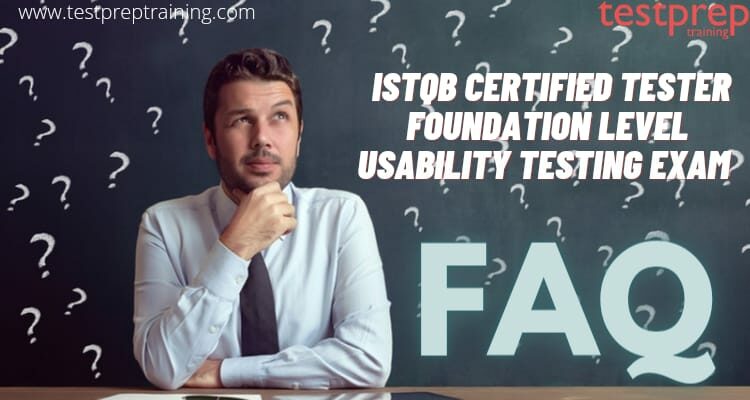ISTQB Certified Tester Foundation Level Usability Testing

The ISTQB Certified Tester Foundation Level Usability Testing qualification exam is for people involved in software testing, who wish to broaden their knowledge and skills of usability testing and aspire to start a specialist career in usability testing. Hence, this exam validates the candidate’s abilities and understanding of usability testing and is really beneficial for professionals involved in usability engineering.
Eligibility Criteria
However, to be eligible to take the ISTQB Certified Tester Foundation Level Usability Testing exam, it’s recommended for you to have achieved a foundation point in your career in software testing and must have passed the ISTQB Foundation Level certificate exam.
Benefits
Consequently, passing the ISTQB Certified Tester Foundation Level Usability Testing exam enables the candidate in-
- Understanding the basic concepts of usability and usability testing.
- Setting up processes so that stated usability, user experience, and accessibility goals may be verified in practice for a given product.
- Designing and monitoring the implementation of test plans for achieving stated usability, accessibility goals, and user experience.
- Identifying and classifying the severity of usability risks and potential accessibility violations in a product at any stage of a development cycle.
- Citing relevant standards for usability, user experience, and accessibility and verifying their implementation in a product.
- Describing the rationale, process, and results of usability, user experience, and accessibility evaluations to non-specialist stakeholders.
Learning Outcomes
Additionally, the ISTQB Certified Tester Foundation Level Usability Testing exam has the following learning objectives-
- Understanding the concepts of usability, user experience, and accessibility.
- Understanding the objectives of usability, user experience, and accessibility evaluation.
- Comparing usability, user experience, and accessibility evaluation.
- Knowing about the three approaches to usability, user experience, and accessibility evaluation: Usability review, usability testing, and quantitative user surveys for satisfaction measurement.
- Understanding the differences between formative (qualitative) and summative (quantitative) usability evaluation.
- Knowing about the key elements of human-centered evaluation.
- Understanding the human-centered design process.
- Knowing the usability evaluation approaches that work well in agile software development lifecycles.
- Understanding typical usability, user experience, and accessibility risks
- Analyzing a given project at the design or evaluation stage, and identify the types of usability risks that are likely to occur
- Understanding the usability aspects of a software application using the usability review method “heuristic evaluation” according to a checklist provided in the syllabus
- Analyzing the principal steps in the usability testing approach
- Understanding the content of a usability test plan
- Understanding the content of a usability test script
- Defining a simple usability test task for a given project
- Understanding the general content and applicability of ISO usability standards and manufacturer guidelines to particular types of project
- Understanding the advantages and disadvantages of a usability test lab
- Studying the key activities in a usability test session
- Understanding the procedure to apply for analyzing findings from a usability test
- Studying considerations to be applied when deciding on a location for usability tests
- Understanding the principal tasks and responsibilities of the Usability Tester
- Understanding the principal tasks and responsibilities of the Moderator and the Note-Taker
Exam Details
| Module | ISTQB Certified Tester Foundation Level Usability Testing |
| Exam Duration | 60 minutes/ 75 minutes(for those who are not taking exam in their spoken language) |
| Passing Score | 65% |
| Number of Questions | 40 |
| Type of Questions | Multiple-choice type |
For more details and any other queries, visit the ISTQB Certified Tester Foundation Level Usability Testing exam FAQs
ISTQB Certified Tester Foundation Level Usability Testing exam Course Outline
Further, the syllabus for the ISTQB Certified Tester Foundation Level Usability Testing exam has been divided into sections and subsections, given as follows-
1. Basic Concepts
1.1 Fundamentals
1.1.1 Usability
1.1.2 User Experience Concepts
1.1.3 Accessibility
1.2 Evaluating Usability, User Experience, and Accessibility
1.2.1 Usability Evaluation
1.2.2 User Experience Evaluation
1.2.3 Accessibility Evaluation
1.3 Usability Evaluation in Human-Centered Design
1.3.1 Usability Requirements
1.3.2 Agile Usability Evaluation
2. Risks in Usability, User Experience and Accessibility
2.1 Introduction
2.2 Typical Risks
2.2.1 Usability Risks
2.2.2 User Experience Risks
2.2.3 Accessibility Risks
2.2.4 Project Risks
3. Usability and Accessibility Standards
3.1 Usability Standards and Manufacturer Guidelines
3.1.1 ISO Usability Standards
3.1.2 Manufacturer Guidelines
3.2 Accessibility Standards
3.2.1 ISO Standards
3.2.2 The Web Content Accessibility Guidelines
3.2.3 Accessibility Legislation
4. Usability Reviews
4.1 Introduction and Approach
4.1.1 Step-By-Step Approach to Usability Reviews
4.1.2 Risks and Challenges
4.2 Types of Usability Review
4.2.1 Informal Usability Review
4.2.2 Expert Usability Review
4.2.3 Heuristic Evaluation
5. Usability Testing
5.1 Introduction
5.2 Step-By-Step Approach to Usability Testing
5.3 Prepare Usability Test
5.3.1 Usability Test Plan
5.3.2 Usability Test Script
5.3.3 Usability Test Tasks
5.3.4 Test Location
5.3.5 Usability Test Lab
5.3.6 Pilot Usability Test Session
5.4 Conduct Usability Test Sessions
5.5 Analysis of Findings
5.6 Communicate Results and Findings
5.6.1 Results
5.6.2 Usability Findings
5.6.3 Selling Findings to Stakeholders
5.6.4 Usability Test Report
5.6.5 Best Practices in Usability Test Reporting
5.7 Quality Control of a Usability Test
5.8 Challenges and Frequent Mistakes
6. User Surveys
6.1 Introduction
6.2 Step-By-Step Approach to User Surveys
6.3 Standardized Questionnaires
7. Selecting Appropriate Methods
7.1 Criteria for Selecting a Method
7.1.1 Selecting a Usability Evaluation Method
7.1.2 Selecting a User Experience Evaluation Method
7.1.3 Selecting an Accessibility Evaluation Method
8. Summary of Roles and Responsibilities
8.1 Usability Tester
8.2 Moderator and Note-Taker
ISTQB Certified Tester Foundation Level Usability Testing Exam Study Guide
Firstly, you should familiarize yourself with all the topics and subtopics that are there in the exam syllabus. So, this will help you gather a fair idea about required learning and will help you distribute your learning preparation. Also, the practical application of what you learn is really important so keep that in mind while studying. So, start your preparation by going through the syllabus well.

Go through the details of exam
Consequently, the next step towards preparing for the exam is to thoroughly go through the details of the exam including details about the type and number of questions and also the time allotted. Accordingly, this helps you give a direction to your learning and also analyze the time allotted so as to manage time well, during the exam. So, check the model papers and analyze them well and thus, make sure that you are aware of the pattern of the exam.
Study Resources
Consequently, for your convenience, we have compiled the best study resources for your preparation
- If you wish to study from books then this reading is highly recommended:
- Lorin W. Anderson, David R. Krathwohl (eds.) (2001) A Taxonomy for Learning, Teaching, and Assessing: A Revision of Bloom’s Taxonomy of Educational Objectives, Allyn & Bacon
- Jakob Nielsen, Heuristic Evaluation, in Jakob Nielsen, Robert L. Mack (eds.) (1994), Usability Inspection Methods, John Wiley & Sons
- Also, ISTQB provides the following study material in their downloads section-
- White papers(to access Click here)
- Syllabus related articles(to access Click here)
- Glossary
- You can also check out these model papers for a better understanding of the pattern of the exam and the type of questions asked.
- One can further look for training in the ISTQB accredited training providers in one’s local area. You can check the list of training providers from the website of ISTQB.
Join study groups
Moreover, joining study groups and communities can also prove to be of great help. Thus, this acts as a platform that connects professionals and beginners which in a way helps you get your queries solved and alongside, gives you the opportunity to have healthy discussions with peers from the same background. Therefore, joining these groups helps to keep you updated.
Practice tests
However, the most crucial step of preparation is practicing questions. This helps in refining the knowledge that you have gathered from different study resources. Therefore, this helps in evaluating your current preparation and helps boost your confidence and hence the actual exam feels like just another practice test. Moreover, there are various practice tests available online, but the reliability of the practice tests we offer is really high. Here, we provide-
- unique sets of professionally designed questions that make it easier for the candidate to give the actual exam
- mock tests
- allows you to create your own practice tests
- has a pool of experts to address your queries


